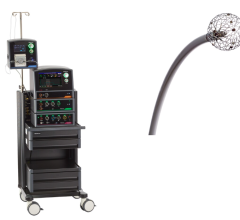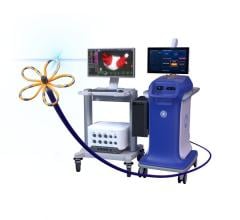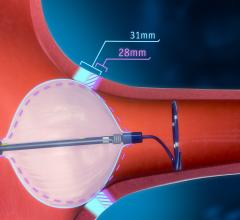
October 14, 2011 – CardioFocus Inc., developer of the HeartLight endoscopic ablation system (EAS) for the treatment of atrial fibrillation (AF), announced that its HeartLight EAS was used to achieve successful acute pulmonary vein (PV) isolation and restore sinus rhythm in a persistent AF patient during a live case at the Venice Arrhythmias 2011 conference, Oct. 9-12 in Venice, Italy.
Additionally, research presented during the scientific sessions further supports the ability of the compliant balloon system to accommodate varied vein anatomy with a single catheter, achieving 99 percent acute isolation irrespective of vein size and shape.
“The live case outcome and clinical findings presented at the conference are exciting, as they’ve revealed the HeartLight EAS may be suitable for a larger sub-set of patients who are otherwise unable to be treated with a single ablation catheter. We are pleased that research continues to instill confidence in the technology and support its versatile clinical use,” said Stephen Sagon, president and CEO of CardioFocus.
In the live case, physicians successfully isolated all four PVs of a patient with persistent AF and restored the patient to normal sinus rhythm. The procedure was performed by leading electrophysiologists Sakis Themistoclakis, M.D., of Dell’Angelo Hospital and Andrea Natale, M.D., of Texas Cardiac Arrhythmia Institute at St. David's Medical Center, Austin, Texas. The session was chaired by Petr Neuzil, M.D., of Na Homolce Hospital, Prague, Czech Republic.
To perform the case, the physicians employed the new HeartLight EAS handle configuration for the first time in Italy. The enhanced handle was designed for single-handed control of both catheter manipulation and the location of energy delivery to improve procedural efficiency.
Themistoclakis said, “The HeartLight EAS compliant balloon catheter allows for very good contact with all PVs to deliver a circumferential lesion pattern, which in our experience has translated to more efficient, durable vein isolation. In this particular case, it even enabled conversion to normal sinus rhythm during the ablation of the right superior pulmonary vein. We are optimistic that the system will continue to achieve promising outcomes in patients with both paroxysmal and persistent AF.”
The efficacy and precision of endoscopically guided catheter ablation was further supported by a study evaluating the ability of the system to ablate PVs of varying anatomy in 29 unselected paroxysmal AF patients. The research was performed by Boris Schmidt, M.D., and KR Julian Chun, M.D., of Cardioangiologisches Centrum Bethanien, Frankfurt, Germany and presented by Melanie Gunawardene, M.D., also of Cardioangiologisches Centrum Bethanien. They found that visually guided PV isolation was achieved in 72 percent of veins (83/116) on the very first attempt and that electrical isolation was ultimately confirmed with a diagnostic spiral catheter in 99 percent of the PVs attempted (115/116) using only a single HeartLight EAS catheter.
Since its introduction in 2009, the visually guided HeartLight EAS has been used to treat approximately 400 patients with AF in the United States and in Europe. It incorporates a compliant, dynamically adjustable balloon catheter designed for improved contact with the PV ostium, and utilizes laser energy for more efficient, durable and precise ablation treatment.
For more information: www.CardioFocus.com


 October 30, 2024
October 30, 2024 








